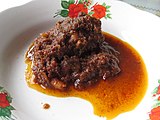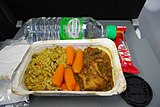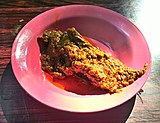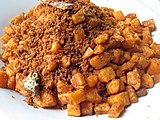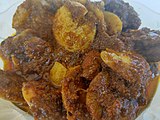Rendang
 Authentic Minangkabau (Padang), Indonesia, beef rendang has a dark colour, with very little liquid content. | |
| Alternative names | Randang (in Minangkabau) |
|---|---|
| Course | Main course |
| Place of origin | Indonesia[1][2] |
| Region or state | West Sumatra[3] |
| Associated cuisine | Indonesia,[4] Malaysia, Singapore, Brunei |
| Serving temperature | Hot or room temperature |
| Main ingredients | Meat (beef, lamb or goat), coconut milk, chilli, ginger, galangal, turmeric, lemongrass, garlic, shallot |
| Variations | Chicken rendang, duck rendang, liver rendang, spleen rendang |
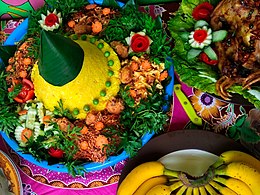 |
| This article is part of the series on |
| Indonesian cuisine Masakan Indonesia |
|---|
|
|
Rendang is an Indonesian spicy meat dish originating from the Minangkabau region in West Sumatra, Indonesia.[5] It has spread across Indonesia to the cuisines of neighbouring Southeast Asian countries such as Malaysia, Singapore, Brunei and the Philippines.[2] Rendang is often described as a rich Southeast Asian curry that's made by stewing meat in coconut milk and spices until it becomes tender.[6] Rendang is a piece of meat — most commonly beef (rendang daging) — that has been slow cooked and braised in a coconut milk and spice mixture,[7][8] well until the liquids evaporate and the meat turns dark brown and tender, becoming caramelized and infused with rich spices.
As the signature dish of Minangkabau culture, rendang is traditionally served at ceremonial occasions to honour guests during festive events; such as wedding feasts and Hari Raya (Eid al-Fitr).[9] Rendang is also traditionally served among the Malay community in Indonesia, Malaysia, Singapore and Brunei, as well as the Maranao in the Philippines.[10] Although culinary experts often describe rendang as a curry,[5] the dish is usually not considered as such in Indonesia or Malaysia since it is richer and contains less liquid than is normal for curries.[11]
In Indonesia, 6 traditions of rendang has been recognised as intangible cultural heritage by the Indonesian Ministry of Education and Culture, all are registered under West Sumatra province. They are randang (Minang spelling),[12] and gulai rendang,[13] both appointed in 2010. Randang daging (meat rendang),[14] randang kantang (potato rendang),[15] and randang incek kacang,[16] those three appointed in 2016. While rendang paku (fern rendang) of Dharmasraya, appointed in 2018.[17]
In 2011, an online poll of 35,000 people by CNN International nominated beef rendang as the No. 1 World's most delicious dish in their World's 50 most delicious foods: Readers' picks list (even though it was #11 on the original list produced by the staff).[18][19] In 2018, rendang was officially recognised as being one of the 5 national dishes of Indonesia; the others are soto, sate, nasi goreng, and gado-gado.[20]
History
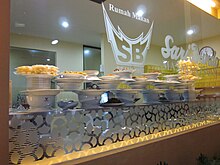
The origin of rendang could be traced back to the Indian merchants links to West Sumatra before the 15th century. Due to regular contacts between India and West Sumatra since the early second millennium, there are possibilities that north Indian curry was the precursor of rendang. Indian curry was adopted by the Minangkabau people as gulai, a local version of curry. Minangkabau people then cooked this gulai further in order to prepare kalio also known as wet rendang. This cooking process was then continued until it thickened and became rendang or also known as dry rendang.[21]
Andalas University historian, Prof. Gusti Asnan suggests that rendang began to spread across the region when Minangkabau merchants began to trade and migrate to Malacca in the 16th century, "Because the journey through the river waterways in Sumatra took much time, a durable preserved dry rendang is suitable for a long journey."[22] The dried Padang rendang is a durable food, good to consume for weeks, even when left at room temperature.[23] One of the earliest written records of rendang is from the Malaccan Malay manuscript of Hikayat Amir Hamzah,[24] Rendang originated in the Sumatran Minangkabau region and the making of rendang spreads from Minangkabau highlands to Mandailing, Riau, Jambi, across the strait to Malacca and Negeri Sembilan, resulting in a variety of rendang traditions.[25]
During the Indonesian National Revolution in 1946, the Indonesian First Lady Fatmawati, the wife of Sukarno, cooked and sent rendang to boost the morale of Indonesian republic freedom fighters around Yogyakarta. Declined by household helps, she insisted on buying beef and went to the market herself by becak, despite being pregnant at the time.[26]
The popularity of rendang has spread widely from its original domain because of the marantau (migrating) culture of Minangkabau people. In the modern era, Overseas Minangkabau leave their hometown to start a career in other Indonesian cities as well as neighboring countries, and Padang restaurants, Minangkabau eating establishments that are ubiquitous in Indonesian cities, spring up. These Padang restaurants have introduced and popularized Minangkabau style rendang and other Padang food dishes across Indonesia, Malaysia, Singapore, and the wider world.
Cultural significance

Rendang is revered in Minangkabau culture as an embodiment of the philosophy of musyawarah, discussion and consultation with elders.[27] It has been claimed that the four main ingredients represent Minangkabau society as a whole:[28][29]
- The meat (daging) symbolises the Niniak Mamak, the traditional clan leaders such as the datuk, the nobles, royalty, and revered elders.
- The coconut milk (karambia) symbolises the Cadiak Pandai, intellectuals, teachers, poets, and writers.
- The chilli (lado) symbolises the Alim Ulama, clerics, ulama and religious leaders. The hotness of the chilli symbolises Sharia.
- The spice mixture (pemasak) symbolises the rest of Minangkabau society.
In Minangkabau tradition, rendang is a requisite dish for special occasions in traditional Minang ceremonies, from birth ceremonies to circumcision, marriage, Qur'an recitals, and religious festivals such as Eid al-Fitr and Eid al-Adha.[30]
In 2011, rendang placed 11th place on a list of World's 50 best foods published by CNN International.[31] An online reader's poll of 35,000 voters chose beef rendang as the top dish on CNN International's Readers' picks list.[18]
The Indonesian Ministry of Education and Culture have included six rendang preparations under its National Intangible Cultural Heritage of Indonesia list, all of which are registered under West Sumatra: Randang (Minang spelling),[32] and gulai rendang,[33] were part of the inaugural list in 2010. They were joined by randang daging (meat rendang),[34] randang kantang (potato rendang),[35] and randang incek kacang,[36] in 2016. Rendang paku (fern rendang) of Dharmasraya, is the most recent addition as of 2018.[37]
In 2018, rendang was officially recognised by the Indonesian government as one of the country's five national dishes: the others are soto, sate, nasi goreng, and gado-gado.[38]
Composition and cooking method

Rendang is most often described as meat slow-cooked in coconut milk and spices until it becomes tender.[39][8] If cooked properly, dry rendang can last for as long as four weeks.[23] Prior to refrigeration technology, this style of cooking enabled preservation of the large amount of meat.[40] The cooking technique flourished because of its role in preserving meat in a tropical climate.[22] Its durability is one of the reasons that today, prepackaged rendang is sent as food aid relief for natural disaster survivors in Indonesia.[8] The cut of beef suitable for rendang is lean meat of the rear leg of the cattle; i.e. topside or round beef, which is considered perfect for slow cooking.[41]
Rendang is rich in spices. Along with the main meat ingredient, rendang uses coconut milk and a paste of mixed ground spices, including ginger, galangal, turmeric leaves, lemongrass, garlic, shallots, chillis and other spices. This spice mixture is called pemasak in Minangkabau. The spices, garlic, shallot, ginger and galangal used in rendang have antimicrobial properties and serve as natural organic preservatives.[42] Although some culinary experts describe rendang as a curry,[39][5][23] the dish is usually not considered as such in Indonesia or Malaysia since it is richer and contains less liquid than is normal for curries.[43]
Traditionally the term rendang does not refer to a certain type of dish. The verb merendang actually refers to a method of slow cooking; continuously churning the ingredients in a pot or frying pan, on a small fire, until all of the liquids evaporate and the meat is well done.[44] Traditional Padang rendang takes hours to cook. Cooking rendang involves pounding and grinding ingredients as well as slow cooking, and so is time-consuming and requires patience.[45] The meat pieces are slowly cooked in coconut milk and spices until almost all the liquid is gone, allowing the meat to become tender and absorb the condiments. The cooking process changes from boiling to frying, as the liquid evaporates and the coconut milk turns to coconut oil.[46] Cooking the meat until tender with almost all the liquid evaporated requires great care, keeping it from getting burnt. Because of its generous use of numerous spices, rendang is known for having a complex and unique taste.
Rendang is often served with steamed rice, ketupat (a compressed rice cake) or lemang (glutinous rice cooked in bamboo tubes), accompanied with vegetable side dishes such as boiled cassava leaf, cubadak[47] (young jackfruit gulai), cabbage gulai and lado (red or green chilli pepper sambal).
- Stages of rendang cooking
-
Early on, the coconut milk is still abundant.
-
Then, the coconut milk starts to evaporate and become oily.
-
By the end, the coconut milk has almost evaporated completely and the meat has darkened.
-
The final dish is less liquid than a curry.
-
Served with nasi rames
Types

In Minangkabau culinary tradition, there are three recognised stages in cooking meat in spicy coconut milk. The dish which results is categorised according to the liquid content of the cooked coconut milk, which ranges from the most wet and soupy to the most dry: Gulai — Kalio – Rendang.[48] The ingredients of gulai, kalio and rendang are almost identical with the exceptions that gulai usually has less red chilli pepper and more turmeric, while rendang has richer spices.
If pieces of meat are cooked in spicy coconut milk and the process stopped right when the meat is done and the coconut milk has reached its boiling point, the dish is called gulai. If the process continues until the coconut milk is partly evaporated and the meat has started to brown, the dish is called kalio. For traditional dry rendang, the process continues hours beyond this, until the liquid has all but completely evaporated and the color turns to a dark brown, almost black color. Thus not only liquid content but also color indicate which type of rendang is involved: gulai is light yellow, kalio is brown and rendang is very dark brown. Today, one mostly finds only two simpler categories of rendang: either dry or wet.[49]
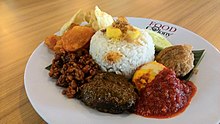
According to Minangkabau tradition, their true rendang is the dry one. Although, unlike crispy dendeng balado spicy jerky, rendang's texture is not actually dry, since it is quite moist and rather oily. Rendang is diligently stirred, attended, and cooked for hours until the coconut milk has evaporated, turned into coconut oil, and the meat has absorbed the spices. It is still served for special ceremonial occasions or to honor guests. If cooked properly, dried rendang can last for three to four weeks stored at room temperature and is still good to consume.[23] It can even last months stored in a refrigerator, and up to six months if frozen.
Wet rendang or kalio

Wet rendang, more accurately identified as kalio, is a type of rendang that is cooked for a shorter period of time and much of the coconut milk liquid has not evaporated. Kalio has quite abundant liquid sauce acquired from cooked coconut milk that partly has turned into spicy oil, which is quite flavourful if consumed with steamed rice. Much of rendang served abroad is actually more akin to kalio or wet version of rendang. If stored at room temperature, kalio lasts less than a week.[9] Kalio usually has a light golden brown colour, paler than dry rendang.
Variations
Rendang is made from beef (or occasionally beef liver, chicken, duck, mutton, water buffalo, or vegetables like jackfruit or cassava). Chicken or duck rendang also contains tamarind and is usually not cooked for as long as beef rendang.[50]
The original Minangkabau rendang has two categories, rendang darek and rendang pesisir. Rendang darek (‘land rendang’) is an umbrella term for dishes from old regions in mountainous areas of the Minangkabau Highlands such as Batusangkar, Agam, Lima Puluh Kota, Payakumbuh, Padang Panjang and Bukittinggi. It mainly consists of beef, offal, poultry products, jackfruit, and many other vegetables and animal products which are found in these places. Rendang pesisir (‘coastal rendang’) is from the coastal regions of Minangkabau such as Pariaman, Padang, Painan and Pasaman. Rendang pesisir mainly consists of seafood, although it is not unusual for them to incorporate beef or water buffalo meat in their rendang.
Indonesian Rendang variations:[22][51][52]
- Rendang ayam: chicken rendang, speciality of Batusangkar and Bukittinggi.[51]
- Rendang ati ampela: rendang made of chicken innards; liver and gizzard.[53]
- Rendang babat: tripe rendang, made of tripes of cattle.[54]
- Rendang babi: pork rendang, the adaptation of rendang by non-Muslim population of Indonesia.[55] Usually consumed in Christian-majority Batak region of North Sumatra and Hindu-majority island of Bali. In Bali, the popularity of rendang has led to this adaptation, since some Balinese Hindus do not consume beef.[56]
- Rendang baluik (rendang belut): eel rendang, speciality of Solok. In the Solok dialect, it is also called ‘randang baluk’.
- Rendang bilih (bilis): bilis fish rendang, specialty of Padang Panjang. In Sumatra, ikan bilis refers distinctly to Mystacoleucus padangensis, a small freshwater fish endemic to Sumatra. In other places, bilis might refer to sea anchovy instead.[57]
- Rendang cubadak (rendang nangka): unripe jackfruit rendang, speciality of Payakumbuh.[58][59]
- Rendang cumi: squid rendang, a seafood variant of rendang usually consumed in coastal area.[60]
- Rendang daging: meat rendang. The most common rendang is made from beef, but may also be from water buffalo, goat, mutton or lamb, speciality of Padang.[51]
- Rendang datuk (rendang kering): dried beef rendang, that instead of using fresh beef cuts, the pieces of meat are dried for four days prior of cooking. Specialty of Muara Enim in South Sumatra.[61]
- Rendang daun kayu (samba buruk): rendang made of various edible leaves, usually leaves of ubi kayu, jirak, mali, rambai, daun arbai, mixed with ikan haruan (snakehead fish), specialty of Payakumbuh.[62]
- Rendang daun pepaya: young papaya leaf rendang.[63]
- Rendang dendeng: Dendeng rendang, thinly sliced dried and fried beef cooked in rendang spice. Also can be made from readily available processed beef jerky.[64]
- Rendang gabus (rendang ikan haruan): Snakehead fish rendang, popular in Payakumbuh.[65]
- Rendang gadih, rendang tumbuk or rendang payakumbuh: Minced beef rendang, tumbuk or pounded beef shaped into balls mixed with coconut, specialty of Payakumbuh, West Sumatra.[66][53]
- Rendang hati: cow liver rendang, speciality of Minangkabau.[52]
- Rendang ikan asap (rendang ikan salai): smoked fish rendang, usually made of smoked ikan pari or ray fish, specialty of Minangkabau.[67][68]
- Rendang itiak (rendang bebek): duck rendang, speciality of Bukittinggi and Payakumbuh.[51]
- Rendang jamur: mushroom rendang.[59]
- Rendang jantung pisang: banana blossom rendang, speciality of Minangkabau.[69][65]
- Rendang jawa: Javanese adoption of Minang rendang, which is more soft and moist suited to Javanese taste, usually rather sweet and less spicy compared to Sumatran rendang.[53]
- Rendang jariang (rendang jengkol): jengkol rendang, commonly popular in West Sumatran towns, especially Bukittinggi, Payakumbuh, Pasaman and Lubuk Basung.[52][70]
- Rendang kambing: goat meat redang.[53]
- Rendang jo kantang: beef rendang with baby potatoes, speciality of Kapau.
- Rendang kelinci: rabbit meat rendang, popular in Aceh.[71]
- Rendang kepiting (rendang ketam): crab rendang, which is crab cooked in rendang spices with sweet soy sauce.[72]
- Rendang lele: Catfish rendang.[65]
- Rendang lidah: beef tongue cooked as rendang.[73]
- Rendang limpa: offal rendang made of cattle spleen.[74]
- Rendang lokan (rendang tiram): marsh clam rendang, speciality of coastal Minangkabau regions such as Pariaman, Painan and Pesisir Selatan.[52]
- Rendang maco: rendang that uses a type of salted fish, specialty of Limapuluh Koto.[69][51]
- Rendang medan: rendang variant from Medan in North Sumatra, slightly different to Minangkabau rendang. It is more fatty and wet akin to kalio and usually less hot and spicy.[75]
- Rendang padang: Padang rendang commonly sold in Padang restaurants nationwide, dry rendang that uses lean fatless meat.[53]
- Rendang pakis (rendang pucuk paku): vegetable rendang made from pakis or fern leaf, specialty of Pasaman.[51][59]
- Rendang paru: cow's lung rendang, speciality of Payakumbuh.
- Rendang patin: Pangasius catfish rendang.[76]
- Rendang petai: stir fried petai and common green beans in rendang spices.[77]
- Rendang pucuak ubi (rendang daun singkong): cassava leaf rendang, speciality of Minangkabau.[69]
- Rendang punai (rendang burung dara): rendang made of burung punai or green pigeon.
- Rendang puyuh: rendang made of burung puyuh or quail.[78]
- Rendang rawit: an extra hot and spicy dried rendang spices mixed with dried cabai rawit (bird's eye chili). Not exactly a dish, but more a condiment akin to serundeng, bawang goreng or chili powder that sprinkled upon steamed rice or noodle.[79]
- Rendang rebung: rendang made of bamboo shoot.
- Rendang runtiah (rendang suir): (lit: "shredded rendang") shredded beef or poultry rendang, speciality of Payakumbuh.[80]
- Rendang sapuluik itam (rendang pulut hitam): dough made of ground black sticky rice cooked and served in rendang spice, specialty of Simalanggang.[62]
- Rendang selais: rendang made of selais (Kryptopterus) fish, a genus of catfish found in rivers of Sumatra, popular in Pekanbaru, Riau.[81]
- Rendang tahu: tofu rendang, a vegetarian variant that uses tofu beancurd instead of meat.[82]
- Rendang talua (rendang telur): egg rendang, speciality of Payakumbuh.[51]
- Rendang tempe: tempe rendang, a vegetarian variant that uses tempeh soybean cake instead of meat.[83]
- Rendang teri: anchovy rendang.[84]
- Rendang tongkol: mackerel tuna rendang, speciality of coastal Minangkabau regions.[85]
- Rendang tuna: tuna rendang.[86]
- Rendang tunjang (rendang kikil): rendang made of cartilage and tendons of cow's trotters.[87]
- Rendang ubi: made of ubi kayu or singkong (cassava).[59]
- Rendang udang: shrimp rendang.[88]
- Rendang usus: intestine rendang, made of offals; the intestines of either poultry or cattle. The cattle intestine rendang is quite similar with gulai tambusu, gulai iso or gulai usus.[89]
Today, rendang is quite widespread in Indonesia, owned mainly by the proliferation of Padang restaurants in the country, which led to popularity and adoption of rendang into the kitchens of contemporary Indonesian households of various ethnic backgrounds. This might led to development of variants with slightly altered tastes to accommodate regional preferences. Other ethnic groups in Indonesia also have adopted a version of rendang into their daily diet. For example, in Java, the rendang—aside from the Padang variety sold in Padang restaurants—tend to be wet, slightly sweeter and less spicy to accommodate Javanese tastes.
Rendang outside Indonesia
Outside of Indonesia, rendang is also known in Malaysia, Singapore, Brunei, southern Thailand, and the southern Philippines as well as in the Netherlands, Australia, Taiwan and Belgium.[3][10]
In Malaysia
Rendang has a long history in Malaysia with distinct versions unique to individual Malaysian states. The different versions of rendang use different ingredients for the spice mix, resulting in differing flavors to the meat.[90]
- Rendang ayam: chicken rendang.
- Rendang ayam goreng: fried chicken rendang.[91] The popularity of this rendang skyrocketed mainly due to the rendangate controversy in 2018.[92][93]
- Rendang daging or Rendang Rembau: dark, woody coloured meat rendang. Traditionally made using water buffalo meat. These days, beef is commonly used instead.
- Rendang daging hitam: Kicap manis-based black-coloured beef rendang, a specialty of Sarawak.
- Rendang dendeng: thinly sliced dried meat rendang.[94]
- Rendang ikan: fish rendang.[95]
- Rendang ikan pari: stingray rendang, a specialty of Perak.[96]
- Rendang itik: duck rendang, a specialty of Negeri Sembilan and Sarawak. In Sarawak, the duck is roasted first so that the meat is soft and not sticky.[97] In Negeri Sembilan, the duck is preferred to be smoked first.
- Rendang puyuh: quail rendang.[98]
- Rendang kupang: mussels rendang.[99]
- Rendang rusa: venison rendang.
- Rendang udang: prawn rendang, a specialty of Perak.[100]
- Rendang kambing: goat rendang.
- Rendang kerang: cockle rendang. Commonly served as a side dish for nasi lemak.
- Rendang ketam: crab rendang.[101]
- Rendang kijing: kijing, a type of shellfish, cooked with rendang spices.[94]
- Rendang hati: beef liver rendang, a specialty of Johor.[102]
- Rendang telur: boiled egg rendang.[103]
- Rendang kunyit or rendang Kuala Pilah or rendang kuning: yellow-hued rendang, uses fresh turmeric, lemongrass, and coconut milk but with no onion added at all.[104]
- Rendang landak: porcupine rendang, an exotic meat rendang, a specialty of Sekinchan, Selangor.[105][106]
- Rendang babi: pork rendang. Non-halal rendang that is eaten only by the Chinese and Peranakan community in Malaysia.[107]
- Rendang lengkuas or nasu likku: galangal-based rendang, a specialty of Bugis people in Sabah. Two versions exist in Sabah, wet and dry; both are considered rendang in Malaysia.[108]
- Rendang lokan: lokan rendang, a specialty of Sungai Petani, Kedah.[109]
- Rendang berempah: spice rendang. Emphasizes the abundance of spices in the rendang.[110]
- Rendang paru: beef lung rendang.
- Rendang daun maman: vegetable rendang made from maman leaf, specialty of Gemencheh, Negeri Sembilan.[111]
- Rendang daun pegaga: vegetable rendang made from pegaga leaf.
- Rendang daun puding: vegetable rendang made from the edible leaves of the garden croton, a speciality of Negeri Sembilan.[112]
- Rendang daun ubi kayu: vegetable rendang made from cassava leaf.
- Rendang jantung pisang: banana blossom rendang.[91][113]
- Rendang serundeng: dry meat floss, derived from rendang. It has a long shelf-life and needs no refrigeration, a specialty of Kelantan.[114]
- Rendang Minang: originated from the Minangkabau people who settled in Negeri Sembilan during the 16th century, but has since evolved from the Sumatran rendang version of the recipe.[115]
- Rendang cili api or Rendang Negeri Sembilan or Rendang hijau: greenish-hued rendang, uses cili api instead of red chili that is normally used in other rendang versions, a specialty of Negeri Sembilan.[116]
- Rendang Tok: dry beef rendang created by the royal cooks of Perak, incorporates spices that were typically inaccessible to the general population.[117]
- Rendang Pahang or opor daging: dark red meat stew cooked with rich spice mix.[118]
- Rendang Perak: simpler version of Rendang Tok, a specialty of Perak.
- Rendang Rawa: Rawa version of rendang, less complicated in terms of ingredients.[119]
- Rendang Kedah: reddish-hued rendang, incorporates the use of red sugar, turmeric leaves, kaffir lime leaves due to the Thai influence on the state cuisine, a specialty of Kedah.[120]
- Rendang Kelantan/Terengganu or kerutuk daging: slow-cooked meat mixed with a unique spice known as kerutub, coconut milk, kerisik and some palm sugar.[117]
- Rendang Nyonya: Peranakan version of rendang, a specialty of Peranakan.[121]
- Rendang Sabah: uses white cumin to replace cinnamon and cloves, a specialty of Sabah.[122]
- Rendang Sarawak: incorporates the use of turmeric leaves, a specialty of Sarawak.
- Rendang Siam: Malay-Siamese version of rendang, incorporates the use of Thai inspired ingredients.
In the Netherlands
The Dutch are familiar with rendang through colonial ties and often serve the wet kalio version in the Netherlands—usually as part of a rijsttafel. Indonesian dishes, including rendang, are served in numbers of Indonesian restaurants in Dutch cities, especially The Hague, Utrecht, Rotterdam and Amsterdam.[123]
In the Philippines
In the Philippines, rendang is most commonly associated with the cuisine of the Muslim Maranao people of Mindanao. It differs from the Indonesian versions in the use of the native spice mix palapa as well as the addition of muscovado sugar.[124][125][126]
Fusion rendang
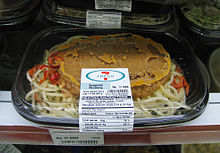
Rendang bumbu is sometimes used as the base of other fusion dishes. Some chefs in Indonesian sushi establishments for example, have developed a Japanese-Indonesian fusion cuisine with recipes for krakatau roll, gado-gado roll, rendang roll[127] and gulai ramen.[128] Several chefs and food industries have experimented with fusing rendang with sandwiches, burgers and spaghetti. Burger King at one time served their take on a rendang-flavoured burger in their Singapore and Indonesia chains for a limited promotion period.[129][130] Spaghetti with rendang could also be found in 7-Eleven convenience stores across Indonesia.
Rendang is also a popular flavour in Indonesian instant noodle variants, such as the Indomie Goreng Rendang.[131]
Most recently, there were Taiwanese baozis with rendang fillings sold at Neo Soho Mall in West Jakarta.[132]
See also
 Rendang at the Wikibooks Cookbook subproject
Rendang at the Wikibooks Cookbook subproject- Cuisine of Indonesia
- Minangkabau cuisine
- Kalio, Indonesian dish
- Massaman curry, Thai dish with similar placing on "most delicious" list
- Kaeng hang le
- Similar dishes identical to rendang:
References
- ^ Keating, Sarah (11 June 2018). "How an outrage over crispy chicken united South-East Asia". www.bbc.com. Retrieved 11 October 2020.
- ^ a b Taylor, Jean Gelman (2003). Indonesia: Peoples and Histories. New Haven and London: Yale University Press. pp. 46. ISBN 0-300-10518-5.
- ^ a b "Should chicken in rendang curry be crispy? Masterchef U.K. sparks debate". Canoe. Associated Press. 3 April 2018. Archived from the original on 5 April 2018. Retrieved 5 April 2018.
The curry (rendang), which originates from West Sumatra in Indonesia, is popular in Malaysia, Indonesia, Singapore, Brunei and southern Thailand.
- ^ Gita Amanda (5 July 2020). "Antropolog: Rendang Bukan Cuma Makanan Tapi Identitas Budaya". www.republika.com (in Indonesian). Retrieved 18 October 2020.
- ^ a b c Owen, Sri (1993). The Rice Book. Doubleday. ISBN 0-7112-2260-6.
- ^ "Malaysians roast MasterChef over chicken rendang elimination". BBC News. 3 April 2018. Retrieved 11 October 2020.
- ^ Holzen, Heinz Von (15 September 2014). A New Approach to Indonesian Cooking. Marshall Cavendish International Asia Pte Ltd. ISBN 978-981-4634-95-3.
- ^ a b c Kautsar, Muthi Achadiat (2 September 2018). "Why beef rendang is the right food to send to natural disaster victims". The Jakarta Post. Retrieved 10 December 2019.
- ^ a b Lipoeto, Nur I; Agus, Zulkarnain; Oenzil, Fadil; Masrul, Mukhtar; Wattanapenpaiboon, Naiyana; Wahlqvist, Mark L (February 2001). "Contemporary Minangkabau food culture in West Sumatra, Indonesia". Asia Pacific Journal of Clinical Nutrition. 10 (1). Blackwell Synergy: 10–16. doi:10.1046/j.1440-6047.2001.00201.x. PMID 11708602.
- ^ a b Thomas, Amanda. "Regional Cuisine of Mindanao". Balay.ph. Archived from the original on 25 March 2019. Retrieved 20 April 2019.
- ^ "Arti Dibalik Masakan Rendang" (in Indonesian). Rendang Naniko. 30 April 2014. Archived from the original on 13 September 2014. Retrieved 13 September 2014.
- ^ "Randang". Cultural Heritage, Ministry of Education and Culture of Indonesia. Retrieved 16 December 2020.
- ^ "Gulai Rendang". Cultural Heritage, Ministry of Education and Culture of Indonesia. Retrieved 16 December 2020.
- ^ "Randang Daging". Cultural Heritage, Ministry of Education and Culture of Indonesia. Retrieved 16 December 2020.
- ^ "Randang Kantang". Cultural Heritage, Ministry of Education and Culture of Indonesia. Retrieved 16 December 2020.
- ^ "Randang Incek Kacang". Cultural Heritage, Ministry of Education and Culture of Indonesia. Retrieved 16 December 2020.
- ^ "Randang Paku Dharmasraya". Cultural Heritage, Ministry of Education and Culture of Indonesia. Retrieved 16 December 2020.
- ^ a b Tim Cheung (7 September 2011). "Your pick: World's 50 best foods". CNNGo. Archived from the original on 11 November 2012. Retrieved 19 May 2015.
- ^ "World's 50 most delicious foods". CNNGo. Cable News Network. 21 July 2011. Archived from the original on 9 October 2011. Retrieved 20 September 2011.
- ^ Media, Kompas Cyber. "Kemenpar Tetapkan 5 Makanan Nasional Indonesia, Ini Daftarnya". KOMPAS.com (in Indonesian). Retrieved 18 April 2018.
- ^ Nurmufida, Muthia; Wangrimen, Gervasius H.; Reinalta, Risty; Leonardi, Kevin (1 December 2017). "Rendang: The treasure of Minangkabau". Journal of Ethnic Foods. 4 (4): 232–235. doi:10.1016/j.jef.2017.10.005. ISSN 2352-6181.
- ^ a b c "Inilah Rendang Minang Juara dunia itu". Urang Minang.com. 12 September 2011. Archived from the original on 22 April 2014.
- ^ a b c d "William Wongso: Duta Rendang di Dunia Kuliner Internasional". Indonesia Proud. 23 November 2010.
- ^ Ahmad, A. Samad (3 April 1987). "Hikayat Amir Hamzah". Dewan Bahasa dan Pustaka, Kementerian Pelajaran, Malaysia – via Google Books.
- ^ Brissenden, Rosemary (2007). Southeast Asian Food: Classic and Modern Dishes from Indonesia, Malaysia, Singapore, Thailand, Laos, Cambodia and Vietnam. Tuttle Publishing. p. 189. ISBN 9780794604882. Retrieved 1 July 2013.
- ^ Maharani, Shinta; Hantoro, Juli (18 April 2018). "Rendang, Nasionalisme Ibu Negara Fatmawati Soekarno". Tempo. Retrieved 6 October 2020.
- ^ Heni Minata (12 January 2012). "Arti Masakan Rendang Minangkabau" (in Indonesian). Kompasiana. Retrieved 20 September 2015.
- ^ Pipiet Tri Noorastuti, Febry Abbdinnah (21 September 2011). "Kisah di Balik Kelezatan Rendang". Viva.co.id (in Indonesian). Retrieved 20 September 2015.
- ^ "Rendang Minangkabau, Warisan Leluhur yang Mendunia". Kebudayaan Indonesia (in Indonesian). 7 August 2015. Archived from the original on 4 March 2016. Retrieved 20 September 2015.
- ^ Albala, Ken (2011). Food Cultures of the World Encyclopedia. Vol. 1. ABC-CLIO. p. 109. ISBN 9780313376269. Retrieved 1 July 2013.
- ^ "World's 50 most delicious foods". CNNGo. Cable News Network. 21 July 2011. Archived from the original on 9 October 2011. Retrieved 20 September 2011.
- ^ "Randang". Cultural Heritage, Ministry of Education and Culture of Indonesia. Retrieved 16 December 2020.
- ^ "Gulai Rendang". Cultural Heritage, Ministry of Education and Culture of Indonesia. Retrieved 16 December 2020.
- ^ "Randang Daging". Cultural Heritage, Ministry of Education and Culture of Indonesia. Retrieved 16 December 2020.
- ^ "Randang Kantang". Cultural Heritage, Ministry of Education and Culture of Indonesia. Retrieved 16 December 2020.
- ^ "Randang Incek Kacang". Cultural Heritage, Ministry of Education and Culture of Indonesia. Retrieved 16 December 2020.
- ^ "Randang Paku Dharmasraya". Cultural Heritage, Ministry of Education and Culture of Indonesia. Retrieved 16 December 2020.
- ^ Senja, Anggita Muslimah Maulidya Prahara (10 April 2018). Nursastri, Sri Anindiati (ed.). "Kemenpar Tetapkan 5 Makanan Nasional Indonesia, Ini Daftarnya". KOMPAS.com (in Indonesian). Retrieved 18 April 2018.
- ^ a b "Malaysians roast MasterChef over chicken rendang elimination". BBC News. 3 April 2018. Retrieved 11 October 2020.
- ^ Brissenden, Rosemary (2007). Southeast Asian Food, Classic and modern dishes from Indonesia, Malaysia, Singapore, Thailand, Laos, Cambodia and Vietnam. Periplus. p. 102. ISBN 978-0794604882. Retrieved 31 October 2014.
- ^ Cornish, Richard (22 July 2019). "The best cuts of beef for slow-cooked dishes". Good Food. Retrieved 11 December 2019.
- ^ Winiati Pudji Rahayu (2000). "Aktivitas Antimikroba Bumbu Masakan Tradisional Hasil Olahan Industri Terhadap Bakteri Patogen Perusak". Bul. Teknol. Dun Zndustri Pangan (in Indonesian). Retrieved 20 September 2015.
- ^ "Arti Dibalik Masakan Rendang" (in Indonesian). Rendang Naniko. 30 April 2014. Archived from the original on 13 September 2014. Retrieved 13 September 2014.
- ^ "Rendang Ternyata Bukan Nama Masakan". Kompas.com. 20 July 2012.
- ^ Asli, Pelaminan Minang Buchyar-Pernikahan Adat Minangkabau. "Rendang Padang Ikon Masakan Indonesia Hadir Di Pameran Wisata Berlin - Pelaminan Minang Buchyar Pernikahan Adat Minangkabau Asli Sumatera Barat".
- ^ "Rendang, Hidangan Terlezat di Dunia". Female Kompas.com. 10 September 2011.
- ^ "Gulai Cubadak | Online Indonesian Food and Recipes". IndonesiaEats.com. 13 September 2010.
- ^ Dian Kelana (17 March 2010). "Gulai, Kalio, atau Rendang?" (in Indonesian). Kompasiana. Archived from the original on 14 September 2014. Retrieved 14 September 2014.
- ^ "Resep Membuat Rendang Basah Maupun Kering". Resep Online (in Indonesian). 21 September 2023.
- ^ Owen, Sri (1999). Indonesian Regional Food and Cookery. Frances Lincoln Ltd. ISBN 0-7112-1273-2.
- ^ a b c d e f g Minangkabaunews. "Inilah 11 Ragam Rendang Minang yang Patut Diketahui - Minangkabaunews". minangkabaunews.com (in Indonesian). Retrieved 23 April 2020.
- ^ a b c d Liputan6.com (14 January 2016). "11 Ragam Rendang yang Patut Diketahui". liputan6.com (in Indonesian). Retrieved 16 June 2020.
{{cite web}}: CS1 maint: numeric names: authors list (link) - ^ a b c d e Mardatila, Ani (21 May 2020). "10 Cara Membuat Rendang Sapi Ala Jawa Hingga Padang yang Empuk, Mudah Dibuat Semua Halaman". merdeka.com. Retrieved 6 October 2020.
- ^ "Resep Rendang Babat". Cookpad (in Indonesian). 2 December 2017. Retrieved 6 October 2020.
- ^ Arofani, Prila. "Resep Rendang Babi yang Gurih, Gak Kalah Nikmat Dibanding Daging Sapi". IDN Times (in Indonesian). Retrieved 6 October 2020.
- ^ Rahadi, Gde (30 September 2018). "Rendang Babi, Lebih Lembut dari Daging Sapi". Bisnis Bali (in Indonesian). Retrieved 6 October 2020.
- ^ "Cara Untuk Memasak Rendang Ikan Bili Khas Padang Panjang. yang Lezat". resep-rendang-bunda.web.app. Retrieved 6 October 2020.
- ^ "Resep Rendang Nangka". hana.
- ^ a b c d Setya, Devi. "5 Rendang Nabati Ini Tak Kalah Enak dari Rendang Daging". detikfood (in Indonesian). Retrieved 6 October 2020.
- ^ Rahman, Naufal Al. "Cara Membuat Cumi Bumbu Rendang, Bumbunya Meresap Sempurna". IDN Times (in Indonesian). Retrieved 6 October 2020.
- ^ Media, Kompas Cyber (24 October 2010). "Rendang Kering Khas Sumatera Selatan". KOMPAS.com (in Indonesian). Retrieved 6 October 2020.
- ^ a b Margaretta, Yosia; Nursastri, Sri Anindiati (25 July 2016). "Aneka Rendang "Vegetarian", dari Daun Kayu sampai Ketan Hitam". KOMPAS.com (in Indonesian). Retrieved 6 October 2020.
- ^ Irmawati (20 December 2017). "Resep Rendang Daun Pepaya". Cookpad (in Indonesian). Retrieved 6 October 2020.
- ^ "Resep Dendeng Sapi Bumbu Rendang oleh Erlyn Damay Agoeng". Cookpad (in Indonesian). 14 February 2017. Retrieved 7 October 2020.
- ^ a b c "InfoPublik - Puluhan Varian Rendang di Payakumbuh". infopublik.id. Retrieved 7 October 2020.
- ^ "Resep Rendang Gadih ( Tumbuk ) Khas Payakumbuh Enak Gurih". Craftlog.com (in Indonesian). Retrieved 6 October 2020.
- ^ "Sajian Rendang Ikan Asap yang Sedap dan Gurih Pengin Nambah Terus, Cobain Yuk Resepnya!". Bangka Pos (in Indonesian). Retrieved 6 October 2020.
- ^ "Resep Rendang Ikan Asap, Hidangan Istimewa Dari Minangkabau". Sajian Sedap (in Indonesian). Retrieved 6 October 2020.
- ^ a b c Angie, Birgitta. "15 Jenis Rendang Paling Enak di Dunia, Ada yang Crispy Gak Ya?". IDN Times (in Indonesian). Retrieved 7 October 2020.
- ^ Media, Kompas Cyber (10 June 2013). "Membuat Rendang Jengkol yang Nikmat". KOMPAS.com (in Indonesian). Retrieved 23 April 2020.
- ^ "Lezat, Ini Dia Olahan Daging Kelinci yang Kaya Protein dan Rendah Kolesterol". portalsatu.com (in Indonesian). 5 June 2017. Retrieved 6 October 2020.
- ^ "Kepiting Bumbu Rendang Kecap". Sajian Sedap. 25 November 2010.
- ^ "Resep Rendang lidah sapi oleh Ayun Hudiawang". Cookpad (in Indonesian). 4 January 2017. Retrieved 6 October 2020.
- ^ "10 resep rendang limpa enak dan sederhana ala rumahan". Cookpad (in Indonesian). Retrieved 6 October 2020.
- ^ "7 resep rendang medan enak dan sederhana ala rumahan". Cookpad (in Indonesian). Retrieved 6 October 2020.
- ^ "Patin Bumbu Rendang, Kreasi Olahan Ikan yang Tak Kalah Lezat dengan Rendang Daging - Sajian Sedap". sajiansedap.grid.id (in Indonesian). Retrieved 6 October 2020.
- ^ "Lezat! Intip Kreasi Buncis Rendang Petai William Wongso". KOMPAS.tv (in Indonesian). Retrieved 6 October 2020.
- ^ Lim, Marco (23 June 2010). "Rendang Puyuh". KOMPAS.com (in Indonesian). Retrieved 6 October 2020.
- ^ "Rendang Rawit: Pedas Gurih Bumbu Rendang Tabur untuk Nasi dan Mi". detikfood (in Indonesian). Retrieved 6 October 2020.
- ^ Fikkry (30 October 2016). "Di Balik Rendang yang Mendunia, Terdapat 6 Variasi Rendang yang Tersembunyi". Hipwee (in Indonesian). Retrieved 6 October 2020.
- ^ Rizky, Theo (11 November 2018). Dani, Candra (ed.). "Satu-satunya di Pekanbaru, Menu Rendang Ikan Selais, Bisa Anda Dapatkan di Pusat Perbelanjaan Ini". Tribun Pekanbaru (in Indonesian). Retrieved 6 October 2020.
- ^ "Vegetarian Rendang Tofu Recipe". Vegetarian Recipes and Cooking. Retrieved 23 April 2020.
- ^ "Resep Rendang Tempe - Rasanya Tak Kalah Lezat Dengan Rendang Daging". Tribun Pontianak (in Indonesian). Retrieved 23 April 2020.
- ^ Fandizal, Muhammad (7 August 2018). "Rendang Ikan Kriwil (Ikan Teri dengan Daun Singkong)". Primarasa (in Indonesian). Retrieved 16 March 2023.
- ^ Fimela (18 July 2017). "Resep Praktis Rendang Tongkol Pedas Manis Enak Banget". fimela.com (in Indonesian). Retrieved 6 October 2020.
- ^ "Resep Masak Tuna Masak Rendang, Kenikmatannya Pasti Jadi Boros Nasi". Sajian Sedap (in Indonesian). Retrieved 6 October 2020.
- ^ Priatmojo, Galih (7 August 2016). Aji, Rustam (ed.). "Empuknya Rendang Kikil ala Hotel Crowne Plaza Semarang". Tribun Jateng (in Indonesian). Retrieved 6 October 2020.
- ^ Bramasti, Ika Putri (16 January 2018). Hutomo, Dimas Setiawan (ed.). "Resep Rendang Udang - Hidangan Istimewa Untuk Makan Bersama Keluarga Tercinta". TribunStyle.com (in Indonesian). Retrieved 6 October 2020.
- ^ "10 resep rendang usus enak dan sederhana ala rumahan". Cookpad (in Indonesian). Retrieved 6 October 2020.
- ^ "Past and Present Practices of the Malay Food Heritage and Culture in Malaysia". Retrieved 29 April 2022.
- ^ a b "8 Jenis Rendang Yang Anda Wajib Cuba". iCookAsia | Asian Recipe & Food Channel. 9 July 2019.
- ^ "Ayam Rendang Goreng". 8 July 2022.
- ^ Bedi, Rashvinjeet (3 April 2018). "Four nations unite against MasterChef UK judge over Rendangate | The Star". www.thestar.com.my.
- ^ a b "Koleksi 10 Resipi Rendang Sesuai Masak Di Hujung Minggu". 7 February 2020.
- ^ "Rendang Ikan Tongkol". 11 October 2021.
- ^ "Rendang Ikan Pari Perak – Stingray Rendang". 13 August 2013.
- ^ "18 Makanan Tradisional Sarawak Kena TRY (UNIK Tapi Sedap)". 30 April 2019.
- ^ "resepi Rendang Burung Puyuh". tumis.my. Retrieved 29 April 2022.
- ^ "Rendang Kupang. Ringkas Tapi Bercitarasa Mewah". 19 October 2017.
- ^ Mohamed, Noor Ainon (30 April 2020). "Rendang udang galah penambat selera MB Perak". Sinarharian.
- ^ Menon, Priya (20 June 2016). "Spicing it up with 12 types of rendang | The Star". www.thestar.com.my.
- ^ Edi, Mas Idayu (28 May 2019). "Kenali Rendang Malaysia Sempena Sambutan Hari Raya Aidilfitri 2019". Murai MY.
- ^ Wahab, Suhaidah Abd (29 May 2019). "Rendang Telur Makan Dengan Nasi Lemak & Pulut Kuning Memang Sedap!".
- ^ Durai, Abirami (19 September 2016). "Great Malaysian dishes: Negri Sembilan – Rendang | The Star". www.thestar.com.my.
- ^ "Makanan eksotik dipaparkan dalam bentuk setem". Berita Harian. 15 February 2019.
- ^ Friday, 15 Feb 2019 04:49 PM MYT (15 February 2019). "Porcupine rendang stamp, anyone? Pos Malaysia celebrates exotic local food | Malay Mail". www.malaymail.com.
{{cite web}}: CS1 maint: numeric names: authors list (link) - ^ Pork, Australian (24 May 2017). "Malaysian pork rendang curry".
- ^ "Senarai 5 Jenis Rendang Mengikut Negeri. Yang Mana Paling Sedap?". Murai MY. 27 June 2020.
- ^ "Lokan Semeling". Sinarharian. 24 July 2020.
- ^ "Rendang Daging Berempah Sedap - Azie Kitchen". www.aziekitchen.com. 16 June 2018.
- ^ GHAZALI, NOR AZIHAN MD (3 June 2019). "Resepi rendang maman yang enak". Sinarharian.
- ^ Rodzi, Tuty Haryanti Ahmad (2 September 2015). "Rendang ayam daun puding enak". Berita Harian.
- ^ "rendang jantung pisang kakbesah". 8 July 2022.
- ^ "Beef Serunding".
- ^ "How rendang got its name and other things to know about rendang | The Star". www.thestar.com.my.
- ^ "8 Makanan Tradisional Negeri Sembilan Yang Wajib Anda Cuba (Dijamin ENAK)". 28 April 2019.
- ^ a b "Rendang | Infopedia". eresources.nlb.gov.sg.
- ^ "Koleksi 10 Menu Tradisi Negeri Pahang Yang Sedap, Memang Berbaloi Cuba Ni". 17 December 2018.
- ^ "Rendang Daging". Simply Enak.
- ^ "Rendang Ayam Kedah".
- ^ "RENDANG NYONYA".
- ^ "Rendang daging Sabah". Berita Harian. 8 July 2017.
- ^ Awesome Amsterdam. "A guide to Dutch-Indonesian food". Expatica. Retrieved 18 June 2019.
- ^ Fenix, Micky (22 August 2018). "Kitchens of Mindanao: Durian custard, 'piyaparan a manok,' Tausug 'tiyula'". Philippine Daily Inquirer. Retrieved 20 April 2019.
- ^ "Popular Muslim Cuisine and Delicacies in CdeO". About Cagayan de Oro. 28 June 2017. Retrieved 20 April 2019.
- ^ "How to Cook Beef Rendang of The Maranao People". Lyn Sojor. 17 February 2019. Retrieved 20 April 2019.
- ^ "Suntiang: Saat Rendang Daging Berkolaborasi Dalam Gulungan Sushi". detikfood (in Indonesian). Retrieved 6 October 2020.
- ^ "New: Suntiang, When Padang Marries Japanese Food". Culinary Bonanza. 6 February 2014. Archived from the original on 5 May 2014. Retrieved 8 November 2015.
- ^ "Rendang Beef". Burger King.
- ^ Rian Farisa (17 September 2013). "Flavor Updates: Rendang Burger (Burger King Indonesia)". The Gastronomy Aficionado.
- ^ "Indomie Goreng Rendang". Indomie. Archived from the original on 29 April 2017. Retrieved 3 April 2018.
- ^ "Hu Jiao Bao: Mantap! Bakpao Khas Taiwan Isi Daging Rendang hingga Cokelat". DetikFood. 17 July 2023. Retrieved 22 November 2023.
External links
 Media related to Rendang at Wikimedia Commons
Media related to Rendang at Wikimedia Commons- BBC: Beef Rendang recipe
- CNN Indonesia Documentary of Rendang (in Indonesian)
- Indonesia Eats: Beef Rendang Recipe (Rendang Daging Minang)
- SBS: Indonesian Beef Rendang
- SBS: Malaysian Food Safari's Beef Rendang recipe






